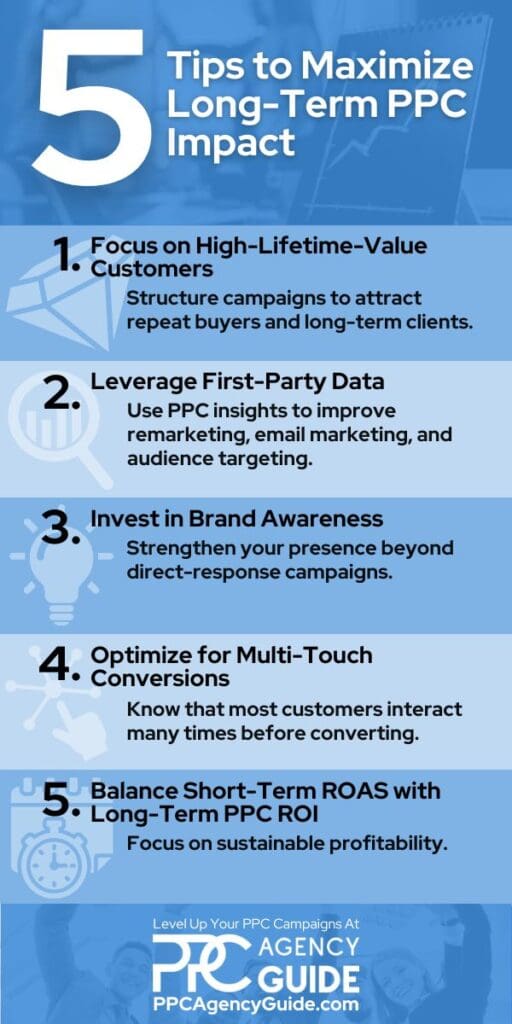
Imagine if you placed an order at a restaurant and received a portion that looked like half of a meal. It might be enough to tide you over, but it’s not going to provide long-term satiety, and it certainly doesn’t deliver the value you expect for your investment. You’d be asking questions, right? Yet, many businesses are willing to accept “half a meal” when it comes to their pay-per-click (PPC) ads by focusing exclusively on the short-term benefits. In reality, the long-term value of PPC campaigns is what really brings you a return on investment and helps you scale. We’ll explore the mechanisms behind this and how to start maximizing the long-term value of your PPC campaigns below.
PPC has Both Long-Term and Short-Term Benefits
The best PPC strategies balance short-term gains with long-term growth. If you only focus on immediate conversions, you might miss opportunities to build brand loyalty, improve targeting, or drive organic traffic. On the flip side, if you only think long-term, you might not see the quick returns PPC is capable of delivering.
Short-Term Benefits of PPC
PPC is known for its ability to drive quick results, which is why many businesses focus on immediate metrics like clicks and conversions. Some of the biggest short-term advantages are covered below.
- Instant Visibility: Your ads appear at the top of search results immediately, bypassing the slow process of organic search engine optimization (SEO).
- Immediate Traffic and Leads: Unlike SEO, which takes months to gain traction, PPC delivers traffic, leads, and sales the moment your ads go live.
- Full Control Over Budget and Audience: You can scale up or down in real time based on performance, controlling costs and targeting your ideal customers.
- Testing and Insights: PPC allows for A/B testing of headlines, landing pages, and offers in real-time, letting you refine your approach quickly.
Key PPC Short-Term Value Metrics
- Click-Through Rate (CTR): Measures how often people click your ad after seeing it.
- Conversion Rate (CVR): Tracks the percentage of visitors who take action, such as making a purchase, signing up, or calling.
- Cost Per Click (CPC): Determines how much you pay per click, helping you assess efficiency.
- Return on Ad Spend (ROAS): Measures immediate revenue vs. ad spend.
Long-Term Benefits of PPC
While the short-term impact is compelling, PPC isn’t just a sprint, it’s a long game, too. Let’s take a look at where the deeper value lies.
- Brand Awareness and Authority: Even when users don’t click, consistent ad exposure keeps your business top-of-mind, making organic conversions more likely down the line.
- Data Collection for Smarter Marketing: PPC gives you invaluable insights into customer behavior, keywords, and messaging that can improve your SEO strategy, content marketing, and overall business decisions.
- Audience Refinement and First-Party Data: Over time, you build remarketing lists, refine audience targeting, and develop higher-quality leads rather than just high-volume clicks.
- Compounding Performance from AI and Automation: Platforms like Google Ads improve campaign performance over time using machine learning, leading to lower acquisition costs and better ad placements.
- SEO Synergy: High-performing PPC campaigns reveal which keywords and messaging work best, helping you guide SEO and content strategies for long-term organic success.
Key PPC Long-Term Value Metrics
- Customer Lifetime Value (CLV/LTV): This helps measure how much revenue a customer generates over their entire relationship with your business.
- Cost Per Acquisition (CPA) Over Time: This shows whether your ad spend efficiency is improving as your campaigns optimize.
- Impression Share and Brand Lift: This Indicates how often your ads appear in relation to competitors and whether brand searches increase over time.
- Attribution Models and Multi-Touch Conversions: This helps track how PPC assists in conversions that don’t happen instantly but occur later through other channels.
How to Measure the Long-Term Value of PPC Campaigns
Short-term PPC success is easy to measure using clicks, conversions, and immediate sales. But how do you determine if your campaigns are delivering long-term value? Unlike short-term metrics, which focus on instant results, long-term value requires tracking customer retention, audience growth, and cumulative performance improvements over time.

Customer Lifetime Value
A strong PPC strategy brings in customers who keep coming back, not just those who make a one-time purchase. CLV helps determine whether your PPC investment is bringing in high-value customers or one-time buyers.
CLV Formula
CLV = (Average Purchase Value) × (Purchase Frequency) × (Customer Lifespan)
For example, if a customer spends $200 per order, buys twice a year, and stays with your business for five years, their CLV is $2,000, far exceeding the revenue from just the first conversion.
It’s worth noting that there are many ways to calculate PPC lifetime value metrics. For instance, some brands also include referrals made by their clients to get a more accurate picture of the total value of each client brought in through PPC.
Why Measuring PPC CLV Matters
If your CPA is $100, but the CLV is $2,000, your PPC campaigns are delivering a strong long-term return on investment (ROI), even if the initial sale isn’t highly profitable.
Cost Per Acquisition Trends
At the start of a PPC campaign, CPAs tend to be higher because your targeting, bidding, and ad performance aren’t fully optimized. Over time, well-managed campaigns should see CPA decrease as:
- Negative keyword lists remove irrelevant clicks.
- Google’s AI improves bid efficiency.
- Retargeting campaigns convert past visitors at lower costs.
If CPA remains high without an increase in conversion volume or quality, it may indicate that your campaign needs optimization or that you’re attracting low-intent traffic.
Branded Search and Direct Traffic
Even when users don’t click on your PPC ads, repeated exposure can drive brand lift, leading to more organic searches and direct visits over time.
- Branded Search Volume: If searches for your company name increase after sustained PPC efforts, it’s a sign that ads are influencing awareness and future conversions.
- Direct Website Traffic: A rise in direct visits (users typing your website URL into their browser) suggests that people are remembering your brand and returning later.
- Assisted Conversions: Google Analytics can show you how often PPC contributes to conversions that happen through other channels, such as organic search or email marketing.
First-Party Data and Remarketing List Growth
The longer you run PPC campaigns, the more first-party data you collect. This includes:
- Remarketing Audiences: Lists of past visitors and high-intent shoppers that can be used for future campaigns.
- Lookalike Audiences: Data-driven segments that help you expand reach to new users with similar behaviors.
- Lead Generation for Email and SMS Marketing: PPC can fuel email marketing, retargeting, and upsell strategies that drive long-term revenue.
If your remarketing lists and customer database are growing, PPC is playing a role beyond immediate conversions, creating an asset that improves marketing efficiency over time.
Attribution Models and Multi-Touch Conversions
Many customers take multiple interactions before making a decision, especially in business-to-business (B2B), high-ticket sales, or complex industries.
- First-Click Attribution: Shows PPC’s role in initial brand discovery.
- Linear Attribution: Distributes credit across multiple touchpoints, helping understand PPC’s role in long-term customer journeys.
- Data-Driven Attribution: Uses machine learning to determine which channels and touchpoints contribute most to conversions.
If PPC assists in conversions that happen through organic search, social media, or email marketing, its impact is broader than direct sales. It fuels an entire ecosystem of customer interactions.
Tips to Maximize Long-Term PPC Impact
PPC campaigns can help build a strong customer base and fuel sustainable growth. The best strategies focus on brand visibility, audience refinement, and long-term profitability. Here’s how to ensure your PPC efforts continue delivering value over time.
1. Focus on High-Lifetime-Value Customers
Some customers generate far more revenue over time than they do from their first purchase. Instead of focusing only on low-cost conversions, adjust your strategy to target audiences with high CLV.
- Identify High-Value Customers: Analyze past purchase behavior to determine which segments generate the most long-term revenue.
- Adjust Bidding Strategies: Increase bids for search terms and audiences associated with repeat purchases or high-ticket products.
- Optimize Landing Pages for Retention: Encourage subscriptions, memberships, or bundled purchases.
For example, a business lending firm running PPC campaigns might bid more aggressively on searches for “best small business loans for expansion” rather than “quick business loan with no credit check.” The first audience is likely to be established businesses looking for long-term financial partnerships, while the second may focus on short-term funding with lower retention potential.
2. Leverage First-Party Data
PPC campaigns generate valuable data that can enhance long-term marketing efforts. Instead of treating every click as a one-time opportunity, use first-party data to nurture leads and re-engage potential customers.
- Build Remarketing Lists: Retarget website visitors who engaged with key pages but didn’t convert.
- Capture and Segment Leads: Use gated content, special offers, or free trials to collect contact information and personalize follow-ups.
- Refine Audience Targeting: Create custom audiences based on behaviors like past purchases, time on site, and engagement with previous ads.
For instance, a SaaS company offering project management software might use PPC to drive free trial signups and then send automated email sequences to convert those users into paying customers.
3. Invest in Brand Awareness
PPC also influences future buying decisions. Even when users don’t click, repeated exposure increases the likelihood they’ll choose your brand later.
- Run Display and YouTube Ads: Introduce your brand to potential customers before they start searching for a solution through YouTube video ads and display ads.
- Protect and Grow Branded Search Traffic: Use PPC campaigns to ensure your business appears first when people search for your name.
- Measure Brand Lift: Track increases in branded search volume, direct website visits, and organic conversions over time.
For example, a law firm running PPC ads might not see an immediate surge in consultations, but consistent ad exposure could lead to an increase in branded searches and direct website visits over time.
4. Optimize for Multi-Touch Conversions
If you only track last-click conversions, you may be undervaluing PPC’s role in your overall sales process.
- Use Multi-Touch Attribution: Switch from last-click attribution to models like linear, time decay, or data-driven attribution to measure PPC’s true impact.
- Analyze Assisted Conversions: Track how often PPC plays a role in sales that are completed through other channels, like organic search or email marketing.
- Retarget Across Multiple Platforms: Serve ads to users who engaged with PPC but didn’t convert, reinforcing your brand across search, social, and display networks.
For instance, a construction firm specializing in commercial real estate development might run PPC ads targeting property investors searching for “best contractors for high-rise projects.” A prospect might click the ad, review project portfolios, and then revisit the site months later after securing financing. If the firm relied only on last-click attribution, they might miss how PPC helped establish the initial connection that led to the contract.
Check out Marketing Attribution 101: A Beginner’s Guide for additional insights and tips.
5. Balance Short-Term ROAS with Long-Term PPC ROI
Many businesses measure PPC success by return on ad spend (ROAS) alone. While ROAS is useful for short-term analysis, it doesn’t account for factors like customer retention, brand growth, or multi-channel influence.
- Compare Customer Acquisition Cost (CAC) vs. CLV: Make sure your PPC-acquired customers are bringing in more long-term revenue than it costs to acquire them.
- Evaluate Retention and Repeat Purchases: Track how often PPC-driven customers return to buy again, and how their behavior compares to organic customers.
- Optimize Bidding for Profitability, Not Just ROAS: Identify which audience segments generate the highest lifetime value and adjust bids accordingly.
For example, a telecom provider offering business internet services might see that PPC leads have a lower ROAS upfront but result in long-term contracts with multi-year commitments. This insight allows them to confidently invest more in the acquisition, knowing that the recurring revenue from each customer far exceeds the initial ad spend.
Improve the Long-Term Value of Your PPC Campaigns
PPC is an investment. If you’re only focused on the short term, you’re missing half the benefits. An experienced PPC agency can apply the strategies outlined here and more to ensure your business is receiving maximum value. To take the first step, request a complimentary consultation.

FAQs on the Long-Term Value of PPC Campaigns
Which metrics should be used for evaluating PPC performance over time?
Key long-term PPC metrics include customer lifetime value (CLV), cost per acquisition (CPA) trends, branded search volume, and assisted conversions. Multi-touch attribution models and first-party data help track how PPC influences organic growth, repeat purchases, and total return on investment (ROI).
Why does customer retention in PPC matter?
Retaining customers acquired through PPC increases profitability and marketing efficiency. Repeat buyers have a lower acquisition cost and higher CLV than one-time customers. By focusing on retention, businesses maximize PPC investments, improving long-term revenue without constantly relying on new customer acquisition.
What methods help with maximizing PPC CLV?
To increase CLV from PPC, businesses should prioritize high-value customer segments, use retargeting to nurture leads, and implement subscription or loyalty programs. Optimizing landing pages for long-term engagement and leveraging first-party data for personalized remarketing can also drive repeat purchases and higher retention rates.
What’s the best method for tracking PPC ROI?
The best approach combines short-term ROAS tracking with long-term ROI analysis. Comparing customer acquisition cost (CAC) vs. CLV reveals whether PPC-acquired customers generate sustainable revenue. Multi-touch attribution models and first-party data help track how PPC contributes to conversions across different marketing channels.
How can PPC contribute to long-term business growth?
PPC supports long-term growth by building brand awareness, generating high-value leads, and refining audience targeting over time. As campaigns optimize, businesses gain lower acquisition costs, stronger customer retention, and better data insights to fuel broader marketing strategies, including SEO, email marketing, and organic social engagement.
What role does brand awareness play in long-term PPC success?
Brand awareness ensures your business stays top-of-mind, even for users who don’t convert immediately. Consistent PPC exposure leads to increased branded searches, direct website traffic, and higher organic conversions over time. Stronger brand recognition also improves click-through rates (CTR) and reduces cost per click (CPC) in future campaigns.
How does PPC impact organic search and SEO over time?
PPC complements SEO by revealing high-performing keywords, driving traffic to new content, and increasing branded search volume. A well-optimized PPC strategy can improve overall search visibility, helping businesses capture more SERP real estate while reinforcing credibility and trust with searchers over time.
What are the best strategies for reducing PPC acquisition costs over time?
To lower acquisition costs long-term, businesses should refine audience targeting, expand remarketing efforts, and use automated bidding strategies. Improving ad relevance, optimizing landing pages, and leveraging first-party data also reduce wasted spend, leading to a higher return on investment (ROI) with lower cost per acquisition (CPA).
How can multi-touch attribution improve long-term PPC performance?
Multi-touch attribution helps businesses understand how PPC contributes to conversions across different touchpoints. Instead of relying solely on last-click attribution, using linear, time decay, or data-driven models provides a clearer view of PPC’s role in the customer journey, allowing for smarter budget allocation and long-term optimization.


















